Barbara Hepworth Class (Year 5/6) Focus on Dinosaurs
Another busy week at Everything Dinosaur, with several school visits and projects successfully completed. Take for example, a recent visit to Year 5/6 at Streethouse Primary in Yorkshire, to provide a provocation for this Key Stage 2 class as they begin their dinosaur and fossil themed topic. The varied and enriched scheme of work devised by the enthusiastic teaching team will run until the end of this term and Everything Dinosaur was invited to the school to provide a morning of dinosaur and fossil themed activities for the class.
The walls of the tidy and well-organised classroom already featured a number of dinosaur and prehistoric animal themed displays.
Posting Up Information About Life in the Past (Upper Key Stage 2)
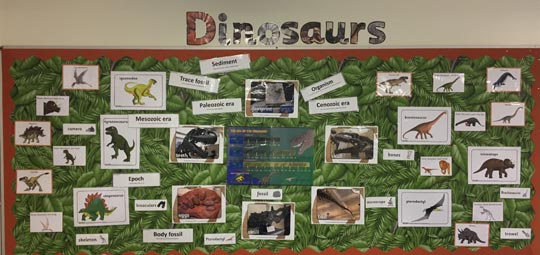
Picture credit: Everything Dinosaur
To contact Everything Dinosaur team members: Email Everything Dinosaur.
Barbara Hepworth Class
Year 5/6 at Streethouse Primary are in Barbara Hepworth class, we are confident that this English 20th century sculptress would be most impressed with the clay prehistoric animal models the children had created. One of the benefits of a dinosaur themed topic is that it lends itself to all sorts of cross-curricular activities, the children eagerly discussed their models and there were certainly some skilfully crafted replicas on display, even winged dinosaurs!
Barbara Hepworth Class Produce Prehistoric Animal Clay Models
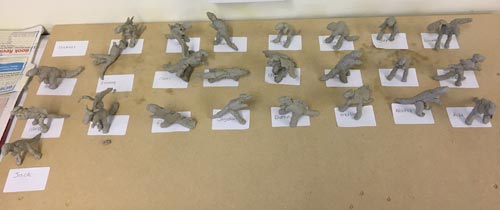
Picture credit: Everything Dinosaur
Answering Questions About Dinosaurs
Prior to the workshop, the children had prepared several questions about prehistoric animals, some of these questions along with answers researched by the children had been posted up around the classroom. The Everything Dinosaur workshop leader incorporated a number of questions into the morning of activities helping to support the children’s learning.
Year 5/6 Compile Questions About Life in the Past
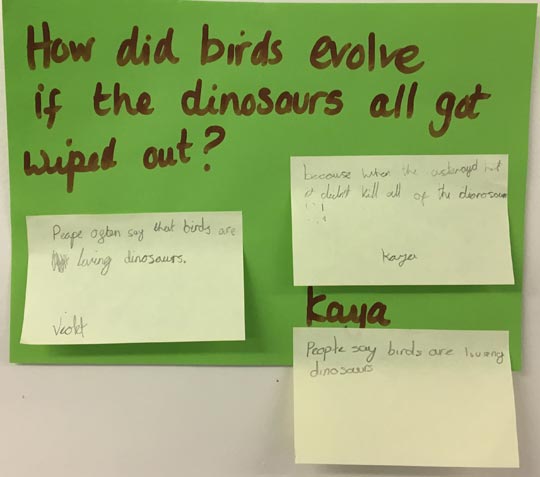
Picture credit: Everything Dinosaur
The above question links in nicely to some of the science curriculum areas associated with Year 6, fortunately, our dinosaur expert had brought plenty of resources with him to help the class explore in a little more detail the evolutionary relationship between avian and non-avian dinosaurs (birds and dinosaurs).
Why Does Tyrannosaurus rex Have Tiny Arms?
Another question, this time, raised by the class teacher, asked why does T. rex have tiny arms compared to the rest of its body? That’s a very challenging question, that ironically had just been covered in a recent presentation delivered to the annual conference of the Geological Society of America. A cast of a T. rex manual ungual (claw bone) came in handy to help explain that this latest theory suggests that the short arms of Tyrannosaurus rex were very effective weapons for slashing prey at close quarters.
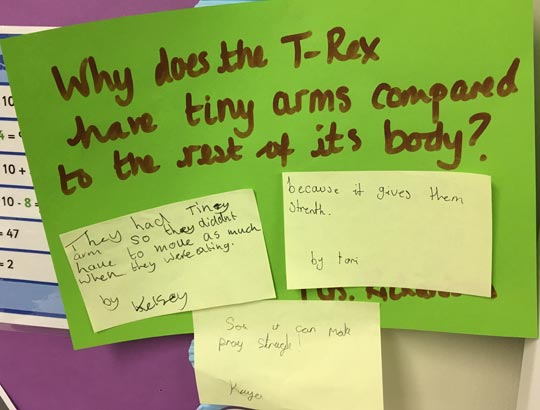
Picture credit: Everything Dinosaur
To see our recent article on the “slashing T. rex” idea: Tiny T. rex Arms Built for Slashing Prey.
All to soon, our morning of dinosaur and fossil themed activities came to an end. However, there was still time to set a couple of extension exercises for the class and to admire the partially complete “Jurassic landscape” that the children had been making. The class will be using ModRoc (plaster of Paris modelling materials), to create a prehistoric scene, all helping to reinforce learning about animals and their habitats. We use similar materials when protecting fossils in the field prior to their full removal. We look forward to seeing the finished dinosaur diorama.
Barbara Hepworth Class are Creating a Prehistoric Landscape
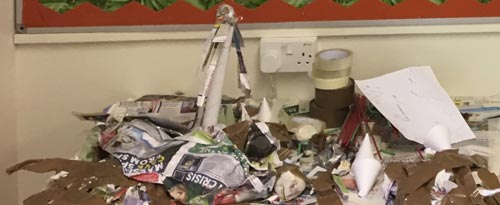
Picture credit: Everything Dinosaur
To the conclude the morning, the children sang a song all about being a palaeontologist, they even managed to pronounce the word “Pachycephalosaurus” correctly – well done to all!
Visit the Everything Dinosaur website: Everything Dinosaur.






Leave A Comment